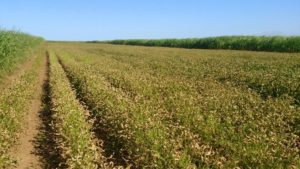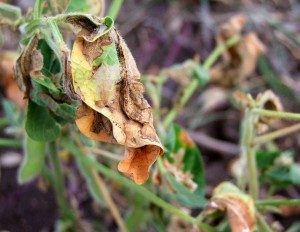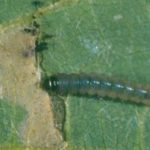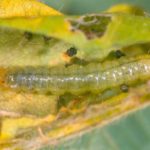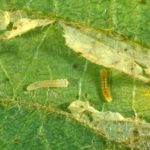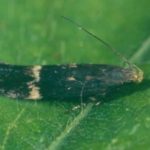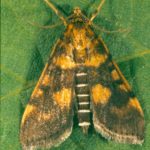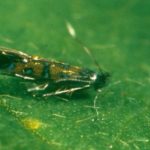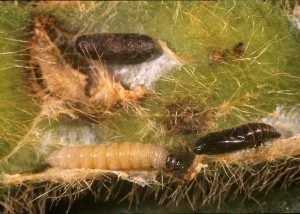Major soybean moth outbreaks have recently been reported in some coastal Burnett soybean crops, and lesser outbreaks in crops in the Burdekin. Soybean moth is generally a minor soybean pest but major outbreaks have been reported periodically in all soybean growing regions. In extreme cases, crops can be totally defoliated.
Feeding damage
Larvae feed mostly within the leaves, making distinctive pale leaf mines, and often distorting leaves with fine webbing.
Soybean moth is usually present in low numbers in most soybean crops. However, in some seasons, a population explosion can lead to huge numbers, sometimes with thousands of larvae per square metre. Such large populations can totally defoliate a crop if not detected and acted upon in time.
Regular crop sampling will pick up the early stages of damaging populations, specifically the numerous pale small feeding mines per leaflet. Stressed sections of a crop are often more heavily infested. Infestations may also be higher along the edge of the crop adjacent to trees.
Identification
Soybean moth larvae are small, reaching only 7 mm in length and are grey-green, but turn pale cream before pupating in folded leaves. Larva should not be confused with the much larger legume web-spinner (14 mm) which is a brighter green, webs leaves together, and feeds externally within the rolled up leaf, rather than mining within the leaf. The other species that they may be confused with is the soybean leaf miner, which also mines in leaves, but their larvae are much smaller, only reaching 2-3 mm in size, and have a noticeable thickening of the body behind the head.
- Soybean moth larva (5 mm) and typical leaf-mining damage
- Legume webspinner (14mm) inside rolled leaf
- Soybean leafminer larvae (2mm) inside cut-open leaf mine
Soybean moths are small (6 mm long) with dark folded wings with a white band. The legume web-spinner moth is much larger (13 mm wingspan) and is brown with yellow markings. The soybean leafminer also has folded wings but is very small (2 mm long) with shining orange wings with white spots ringed with black.
-
Soybean moth adult
(6 mm long)
- Legume webspinner adult (12mm long; 14mm wingspan)
-
Soybean leafminer adult
(6mm long)
Thresholds
Thresholds are based on percentage defoliation. In vegetative crops, 33% leaf tissue death (mining) is allowable before yields are compromised. However, the tolerable percentage defoliation falls to less than 20% during pod-fill.
Control
Soybean moth larvae are easily controlled with abamectin at 300 mL/ha under Permit 14288 (valid until 30 June 2017). Check that larvae are not in the pale pre-pupal stage (see image below) as they will have stopped feeding and will not be controlled by the insecticide. Feeding larvae die inside the leaves and turn an opaque grey colour.
Article by Hugh Brier and Liz Williams. Images by Joe Wessels unless otherwise specified.
Contact:
Hugh Brier, Senior Entomologist DAF Kingaroy Q.
Email [email protected] Phone 0741 821 840 or Mob 0428 188 069
Liz Willliams Research Scientist/Entomology DAF Kingaroy Q.
Email [email protected] Phone 0741 821 818 or Mob 0476 850 415

